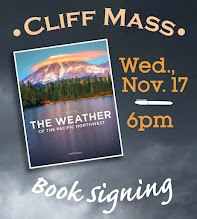The Pacific Northwest is in the Subtropics for a Day
The air feels different today.
Warm, humid, and with a determined breeze that should be moving a grove of palm trees.
Your skin feels moistened and supple, and temperatures will rise to near 60F in the west and as high as 70F over the Columbia Basin.
The Northwest has been transported into the subtropics for a day, the result of an odd meteorological wormhole in meteorological space/time.
This blog will explain.
Some of you may demand proof of the tropical origins of our current air....here it is!
The top figure below shows the trajectories of air over the past five days ending above Tacoma at 500 meters (red), 1000 m (blue), and 2000 m (green). All three air trajecotires come from south of 30 N west of Baja California.
The subtropics.
The bottom panel shows the heights of the air over the past five days.
The transition occurred last night.
Below are observations of wind, temperature, and moisture (dew point temperature) at the University of Washington. Early last evening, the winds switched from northeast to south and accelerated greatly, with some gusts to 15-20 meters per second (around 38 mph!). Temperature and dew point (a measure of moisture) surged upward to around 14 C (roughy 57F)
The strong pressure difference with the front will first cause a surge of powerful westerly winds in the Strait of Juan de Fuca and then strong winds, gusting to 60-80 mph, over the eastern slopes of the Cascades. The wind gust forecast for 7 PM tomorrow is shown below--pretty scary east of the Cascade crest. Expect some power outages on northern Whidbey Island and over the eastern Cascade slopes.
And behind the front, our temperatures will greatly cool, with temperatures over the western lowlands only climbing to the mid-40s for the rest of the week. Snow will return to the mountains. And skiers will hope.....
Announcement:
I will be doing a book signing and dinner event at Ivar's Salmon House in Seattle on Wednesday, November 17th (6 PM). You can come just to purchase a book and get it personalized or you can stay for a special dinner, where I will be giving a weather talk. More information on the event is found here. You need to make reservations for the dinner (only 80 spaces available). And information about the new edition of my book is here.
Half the spot are now reserved, so if you want to go, reserve a place soon.












Comments
Post a Comment